Microsoft Surface Pro 2 Review
by Anand Lal Shimpi on October 21, 2013 12:01 AM EST- Posted in
- Tablets
- Microsoft
- Mobile
- Surface
- Surface Pro 2
CPU Performance
While multitasking on Surface 2 can struggle, the same really can’t be said for Surface Pro 2. The tablet is effectively a Haswell Ultrabook, capable of delivering the exact same performance as a 2013 MacBook Air – but in the form factor of a thick tablet. The performance of Intel’s Core i5-4200U is a fairly known quantity at this point, but to put Surface Pro 2’s tablet performance in perspective here are some comparisons to the best of the best in the ARM tablet space.
I ran tests using both Chrome and IE11, the latter is really only optimized for SunSpider and horribly unoptimized for everything else. In general you're multiple times better performance than what you can get from a quad-core Cortex A15 based device. If we look at Kraken, Surface Pro 2 running IE11 completes the test in 1/4 the time as Surface 2 running the same browser.
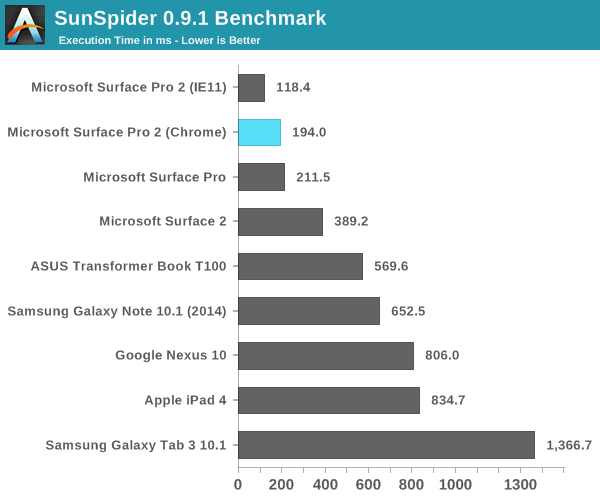
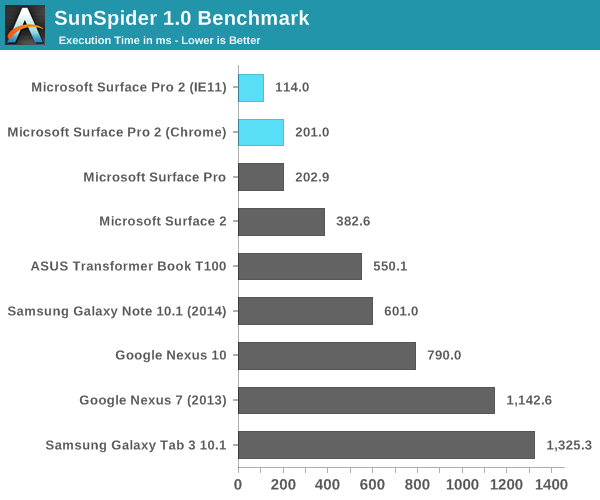


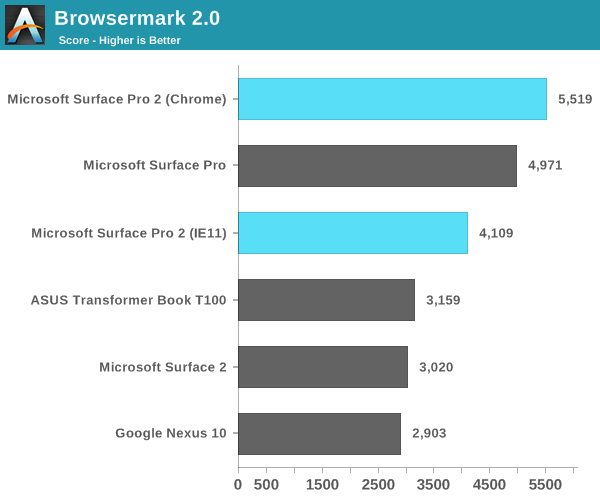
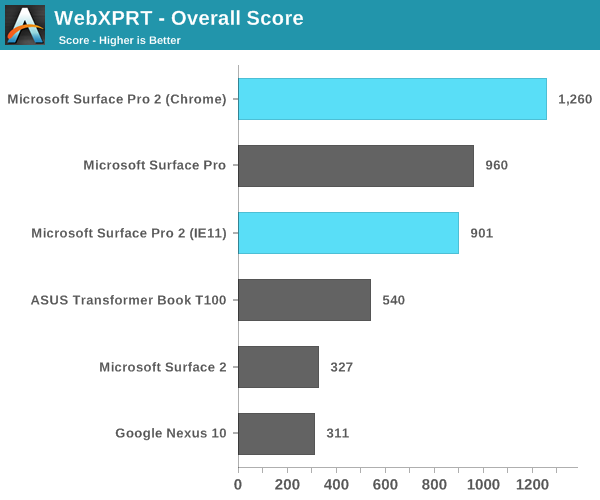
GPU Performance
Intel’s HD 4400 is good enough for light gaming and is a huge step above what you can find in a traditional ARM based tablet. Microsoft only gave us a few days to review both devices so I didn’t have a ton of time to re-characterize the performance of Intel’s HD 4400, but I’ve done that elsewhere already.
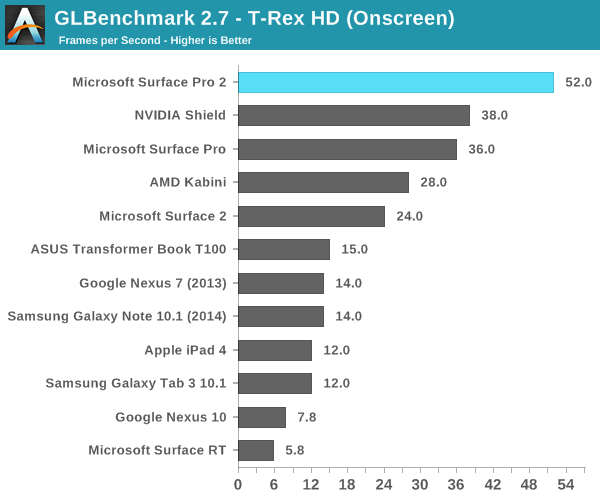
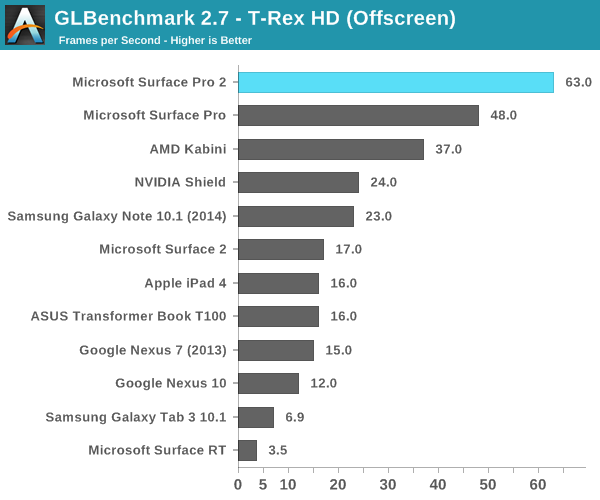
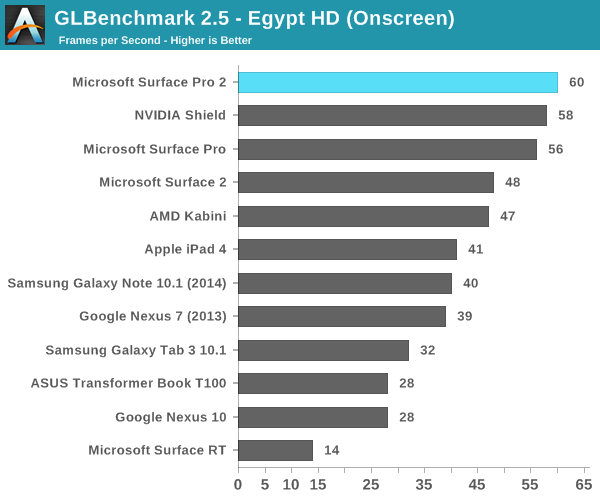
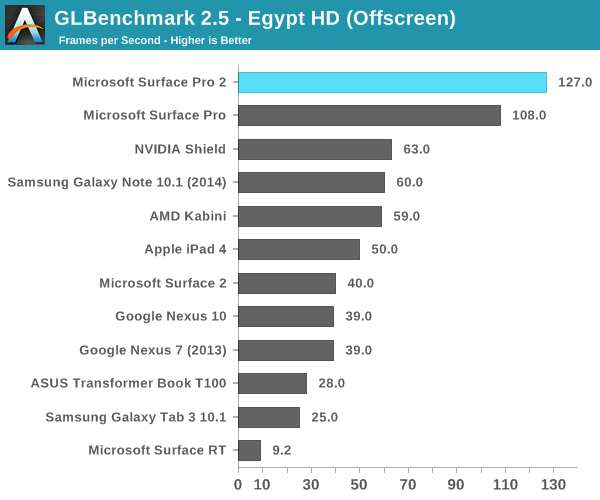
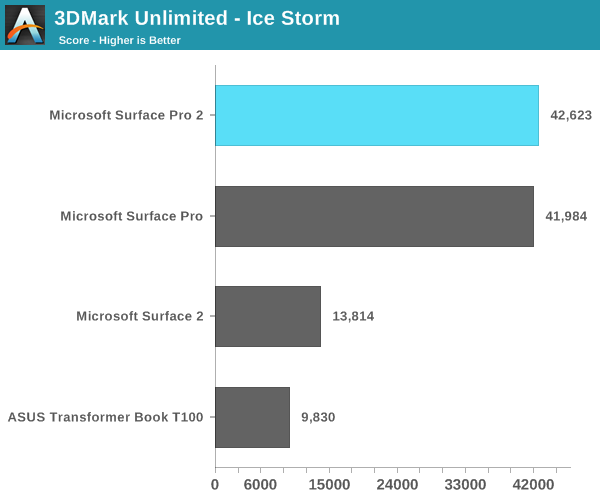
Storage Performance
My review sample appears to have a SK Hynix based SSD. I ran it through the same modified IO tests I did on the ASUS T100:
Our Android IO tests rely on Androbench with a relatively limited LBA span. I increased the difficulty of the test a bit under Windows 8.1 but still kept it reasonable since we are dealing with eMMC solutions. I’m testing across a 1GB LBA span and testing for a period of 1 minute, which is an ok balance between difficulty of workload and sensitivity to the fact that we’re evaluating low-class SSDs here.
Surface Pro 2 is a completely different league of IO performance. The number to pay attention here is the tremendous increase in random write performance compared to the eMMC solutions we’ve tested. I suspect the gap increases if we were to look at worst case sustained random write performance. Killer sequential performance definitely helps Surface Pro 2 feel quick.

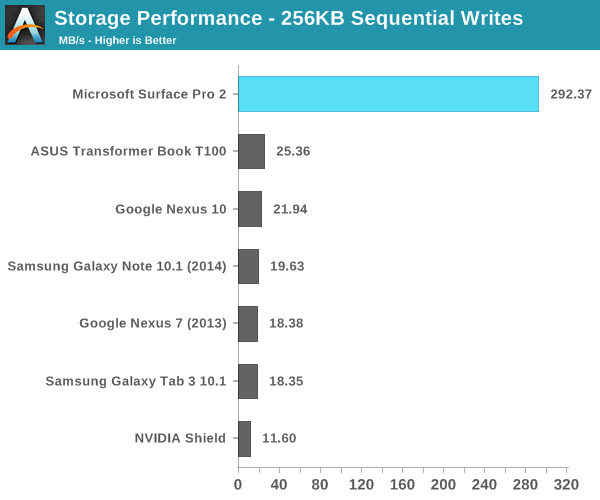
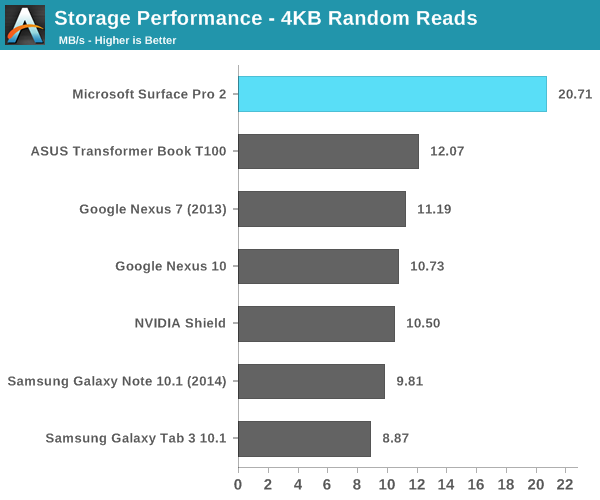











277 Comments
View All Comments
chizow - Monday, October 21, 2013 - link
Exactly! Glad I wasn't the only ones to remember the chief complaints about Surface Pro. Price, size/weight, battery life. They really only addressed the last concern, battery life, and even then it's only marginally better (40%) and still FAR off from other devices that use the same Haswell ULT guts (MBA 2013).I must say Surface 2 Pro is still a disappointment. Surface 2 is much more interesting but the ARM-based Windows RT is just a non-starter for me right now. Wish it was Bay-Trail!
kyuu - Monday, October 21, 2013 - link
It's not true. Surface Pro 2 uses a different chassis than the original; it's 2 pieces instead of 3. Keeping it the same weight/thickness was a deliberate design choice, likely related to not having to redesign the thermal dissipation system, not due to reusing the old chassis.Klimax - Monday, October 21, 2013 - link
Few people. You have only assertion without any evidence, which BTW is all you can get, because poor sales can't be matched to your arbitrary terms with any analysis as there is significant problem with Surface - No World Wide distribution. Hell not even my country, bordering with Germany has it and we fall under EU, but not Irish definition of Europe...BTW: I suspect that only tiny portion of market has same lust after incredibly thin and fragile devices which you have to replace as soon as you drop it by few centimeters, because it suffered serious damage. (Note: Bit hyperbole, but point is, that thinness has severe trade offs in it self including battery and features)
chizow - Monday, October 21, 2013 - link
Right, because we don't have about a billion reasons to think the Surface underperformed last year relative to Microsoft's expectations or anything.....All I got from the Engadget review was a 3-stage kickstand instead of 2-stage, and I do believe that part is linked to just the kickstand itself. Could easily be retrofitted into the old chassis if needed.
backbydemand - Monday, October 21, 2013 - link
Apart from it is not the old chassis, it uses less parts, so is obviously not the sameschuckles - Monday, October 21, 2013 - link
i need to go with sweenish on this one...Microsoft may have over produced the previous gen surface pro/rt but that doesn't mean they are going to order 10's of thousands of a single component (chassis) without also ordering the same amount of all the other sub assemblies and building finished product. MOQ's are largely irrelevant once you go above 10k units, and microsoft already did a massive 1B $
I'm not going to speculate too much on why they didn't do a re-design and get it a few mm thinner, but i would point you to one of the positives in the review - it barely spins up the fans when lightly loaded, and that didn't cost them any time/effort to redesign the heat management on the inside...
KPOM - Monday, October 21, 2013 - link
??? Maybe they haven't changed the chassis because they are selling as many as they like and saw no need to change it. I do think we'll see a more dramatic redesign next year. It's time for the Air to go "Retina" and I think in 2014 they'll be ready to make the leap. OS X doesn't handle 150% scaling particularly well, so they are probably waiting until they can go to 200% economically.This is another reason why I think we're more likely to see iOS "grow up" into a desktop-class OS than OS X and iOS merge. OS X will still be there for enthusiasts and Pro users, but iPad will grow into a more powerful device as Apple makes the push into 64-bit.
Deepcoiler - Monday, October 21, 2013 - link
You must have missed when it what said that the chassis went from being three pieces to two. Microsoft kept the size the same, but did not reuse the old chassis.backbydemand - Monday, October 21, 2013 - link
Shhhhh, let the trolls spread their liesMadMan007 - Monday, October 21, 2013 - link
Looking over the results here and from the Asus T100 article, all I can think is what a shame it is that AMD gets virtually no design wins. I know they wouldn't be comparable to Haswell CPUs, but compared to Bay Trail Kabini is competitive in CPU performance and far better in GPU performance...the only catch would be battery life, but how will we ever know if there are absolutely no devices to compare?